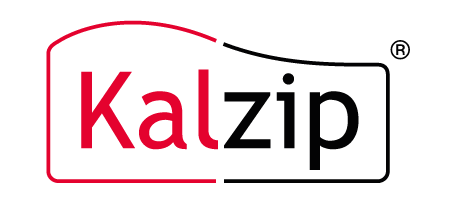About us
Über uns
Products
Produktpalette
Downloads
Downloads




The “Pickering GO Pedestrian Bridge” in the Canadian city of Pickering provides pedestrians with a safe route from the railway station in the south to the city centre in the north. With the Kalzip outer shell illuminated at night, it is a real eye-catcher.

The outer shell was installed in sections during the night so that the motorway did not have to be closed during the day. (Photos: Kalzip GmbH)
The pedestrian bridge in Pickering, Canada is already becoming a landmark in the city: with a length of 250 metres, it has made it into the 2021 Guinness Book of Records as the longest covered pedestrian bridge in the world. The span stretches over six railway tracks and Highway 401, one of the busiest motorways in the north of the USA and Canada with 14 lanes of traffic. The federal and provincial governments and the local transport company Metrolinx launched the pedestrian bridge project to provide visitors from Pickering GO station with a direct and safe connection to the district above the motorway with its shopping mall and local college. The visible Kalzip cladding gives the above-ground tunnel an organic shape. The standing seam profiles are illuminated in the dark evening hours, making the structure visible from the air.

Organic and yet inorganic: the metal pedestrian bridge winds its way across Highway 401 almost like a vein (Photos: Kalzip GmbH)
The pedestrian bridge is a steel truss structure with a concrete floor and a steel deck roof. Normally used as a waterproof building envelope, the standing seam profiles 65/305 from Kalzip were used here for a purely visual effect.The convex curved standing seam profiled sheets are perforated with 6 mm diameter holes spaced 8 mm apart. Thanks to the slight transparency, pedestrians can enjoy natural daylight and protection from direct sunlight as well as a view of Highway 401. The perforated surface also allows the pedestrian bridge to be illuminated with LED light strips both inside and out.
Due to the complex shape of the bridge, the steel structure was first scanned using a terrestrial LiDAR sensor. Using the data obtained as a basis, Kalzip was able to create a plan to bend and cut the standing seam profiles accordingly depending on the section and curvature.

Exposed sections provide an unobstructed view of the motorway and the surrounding countryside. The profiled panels catch the colourful play of light. (Photo: Kalzip GmbH)
In addition to calculations and construction plans, Kalzip also supplied the raw material in coils and a mobile roll-forming machine. A team of American and a German staff member operated the roll-forming machine and produced the standing seam profiles to the required length on site. The machine can be set to the requested profile shape and width and also offers the function of bending the finished profile sheets to the specified radius.
However, the installation of the standing seam profiles posed a somewhat greater challenge. The motorway lanes had to be partially closed to allow work on the outside of the bridge. A large part of the work was therefore carried out at night so as not to unnecessarily disrupt the important traffic route. The installation of the profiled sheets was also different to usual: instead of overlapping at the standing seams, the sheets were attached to the steel frame at slightly different angles. This creates a slight stepped structure depending on the section and viewing angle.
After a total of around ten years from the initial planning to the finished construction, the bridge was completed in 2018. The architecture becomes a highlight, especially in the evening and at night. Around 300 LED lights line the footpath and highlight the organic shapes. The colours of the lights alternate between pale lilac, violet, blue and petrol. Thanks to the AluPlusPatina coating and perforations, the play of light is transmitted both inwards and outwards. In 2019, the building received the “Urban Design Award” from the City of Pickering.

(Photos: Kalzip GmbH)
Contact
Kalzip GmbH
Yannick de Beauregard
Kalzip Marketing
August-Horch-Str. 20 – 22
56070 Koblenz
Phone: +49 261 9834 0
Fax: +49 261 9834 100
E-Mail: yannick.de-beauregard@kalzip.com
The House of Bavarian History is a modern museum complex in Regensburg. The roofscape blends in with the panorama of the surrounding historic city. Profiled sheets from Kalzip were used to design the unusually composed roof area.

On the former so-called Donaumarkt, the façade with its gray, geometric surfaces stands out clearly from the surrounding buildings. Viewed from the other side of the river, the profile of the building blends in with its surroundings: The roof mimics Regensburg’s skyline and thus fills the former gap in the Donaumarkt without trumping the existing building in terms of height.

Not visible to the passer-by: The entire roof is made up of 16 different geometric surfaces that slope in different directions. Adapted to the different angles and building heights, the triangular and trapezoidal surfaces are inclined in different directions and thus form a three-dimensional mosaic.
The Kalzip 65/400 aluminum profile sheets with their AluPlusPatina natural aluminum mill-finish surface contribute to the uniform appearance of the gray-metallic outer shell. On a functional level, the profiles are aligned according to their angle of inclination in order to enable perfect rainwater drainage.

According to the client’s specifications, the House of Bavarian History was to consume as few energy resources as possible. To ensure that as little energy as possible is lost through the outer shell, the decision was made to use the DuoPlus energy-saving roof system from Kalzip when planning the roof. Thanks to its high insulation performance, the system structure minimizes heat loss in winter and protects against solar heat gain in summer.

Contact
Kalzip GmbH
Yannick de Beauregard
Kalzip Marketing
August-Horch-Str. 20 – 22
56070 Koblenz
Phone: +49 261 9834 0
Fax: +49 261 9834 100
E-Mail: yannick.de-beauregard@kalzip.com
The traditional brewery “De Halve Maan” in Bruges, known for its cult beer “Brugse Zot,” stands for innovation and tradition. As part of its expansion, a new bottling plant was built outside the city, impressing with a gold-coloured facade cladding from Kalzip. This not only reflects the colour of the popular blonde beer but also serves as a visible symbol of the brewery’s spirit of innovation.

Located in the heart of Bruges for almost 170 years, the brewery combines historical brewing art with state-of-the-art technology. One example of this is the beer pipeline, over 3 kilometres long, which transports the beer to the new bottling plant in an environmentally friendly and efficient manner. The new site harmonises with these values by emphasising sustainability with a modern water recycling system and a solar system on the roof.
The golden aluminium profiled sheets from Kalzip, coated with AluPlusPatina in the colour Medium Gold G30, are not only visually striking but also represent robust quality and sustainability as they are made from a high percentage of recycled material. The facade also allows for a balance between privacy and natural light through clever perforations.

Large glass fronts and an open, inviting architecture allow visitors and business partners to gain a direct impression of the company. The combination of transparent elements and the distinctive golden facade emphasises the brewery’s commitment to innovation and aesthetics.
With this project, Kalzip has once again underlined its expertise in the realisation of sophisticated and sustainable architectural concepts that are both functional and aesthetically pleasing.

Contact
Kalzip GmbH
Yannick de Beauregard
Kalzip Marketing
August-Horch-Str. 20 – 22
56070 Koblenz
Phone: +49 261 9834 0
Fax: +49 261 9834 100
E-Mail: yannick.de-beauregard@kalzip.com
The enormous regeneration of Alexander Stadium in Birmingham was commissioned by Birmingham City Council, with a requirement for work to be complete in time for the Commonwealth Games in the summer of 2022. A range of products from Kalzip’s extensive range was specified for the project, which involved the construction of a new ‘West Stand’ along with construction of new North and South Bowl seating which increases the overall capacity from 12,700 to 18,000.

The Kalzip FC Cladding was specified for the fascia which extended to the full perimeter of the stadium roof. However, this posed a particular problem as the system isn’t designed to follow a fan shaped elevation when fitting the FC panels vertically. Therefore, a transition detail had to be developed in conjunction with Kalzip’s expert design department, in order to introduce bespoke transition panels at each grid line. This refined the orientation of the line to allow the next bank of panels to be installed correctly onto the subsequent bay.
An adjustable sub-structure was used to create the curve of the roof on to the flat decking. The Kalzip Deck Roof System was used to cover the roof. With this roofing system, a variation of geometries are possible, while also offering quick installation and durability against any weather conditions. Overall, 5,530 m² of Kalzip standing seam profiled sheets were installed on the roof and 830 m² of FC panels cover the facade.
There were a number of challenges to overcome in order to complete Alexander Stadium, including working in line with strict COVID restrictions, so collaboration with all parties was key. Care was taken to ensure that everyone working on the project were able to adapt to the new working systems in order to prevent any drop in efficiency.
John McAllister from Kalzip said: “Due to the pandemic, the general availability of construction materials was more difficult than usual, with reduced availability and an increase in prices. As a result of Kalzip’s long-standing relationships with key primary international producers, we were able to navigate around the issue of material availability with a minimum of disruption, and also assist in keeping things on track and within budget for the client.
“Some of the standing seam panels used on Alexander Stadium measured over 40m in length, which certainly created some issues for us in terms of transportation and movement. The expertise of the team was essential for this, and careful planning was required to ensure that these panels were lifted onto the roof area safely and efficiently. A crane was used to transport the panels, and this ensured that no time was lost.
“Due to the dynamic shape of the stadium and the unique curvature of the roof, each halter clip needed to be set in its own specific position which required a high level of accuracy and attentional to detail. The setting out of halter clips was a meticulous, yet crucial job to the overall finish of the stadium’s roof.”
The Mayor of the West Midlands, Andy Street, who chairs the WMCA said: “It was fantastic to see the regeneration of the Alexander sporting arena, of which the whole region can be proud of, and one fit to host the world’s leading athletes for years to come. But far more importantly the construction works on the stadium played a major role for people’s livelihoods by supporting vital construction jobs and apprenticeships both on site and in the wider business supply chain.”

The overall result was the successful completion of a prestigious project, ultimately the construction provided one of the very best sports stadiums in the country, which played host to the Commonwealth Games. This project also involved the You Matter Communities Scheme, providing local communities and people with an opportunity to access small grants, volunteer time and unused materials from the construction process.
Construction and installation of the World Athletics Class 1 facility, including a new 400m six lane warm up track, the relaying of a new 400m, nine lane competition standard track, formation of a practice throwing field, stadium lighting and various associated highway and infrastructure works were also completed as part of the wider project.

Contace
Kalzip GmbH
Yannick de Beauregard
Kalzip Marketing
August-Horch-Str. 20 – 22
56070 Koblenz
Phone: +49 261 9834 0
Fax: +49 261 9834 100
E-Mail: yannick.de-beauregard@kalzip.com
To celebrate its 55th anniversary, Kalzip organised an anniversary celebration for all employees at the main location in Koblenz Kesselheim. During the celebrations, a donation pot was also opened. In line with 55 years of Kalzip, the staff collected 555 euros. The company itself added an additional 1,555 euros to the amount. The purpose of the donation was clear from the beginning, as explained by Thorsten Klein, authorised representative at Kalzip: “The hospice in Koblenz aims to preserve, strengthen and increase the quality of life and self-determination of seriously ill people, enabling them to live in dignity until their passing. Providing care for children and teenagers, as well as their families, requires special dedication from the healthcare professionals and volunteers. These challenging and important services are organised by a non-profit organisation. That’s why we decided to support SAPV Koblenz für Kids und Teens gGmbH.”
Thorsten Klein and Kalzip personnel officer Sandra Pelzer presented the total sum of 2,110 euros to Janet Weber and Ina Rohlandt, the managing director of SAPV Koblenz für Kids und Teens gGmbH at Hospice Koblenz on 30 August 2023: “As a company, we want to give back to the people in the region and are pleased to be able to support an organisation in our community that relies solely on donations for its funding.”

Present at the official handover of the donation (from left to right): Sandra Pelzer, Personnel Officer Kalzip; Ina Rohlandt, Managing Director SAPV Koblenz; Thorsten Klein, authorised representative Kalzip and Janet Weber, employee of the Koblenz Hospice.
In 2022, a futuristic building complex named Plateforme 10 was opened in the Swiss city of Lausanne, merging two museums under one roof. It houses the Elysée Photo Museum and the mudac, a Museum of Design and Contemporary Art. This newly created art district provides visitors of all generations with over 25,000 m² to explore the diversity and various types of art in the fields of visual arts, photography, and design. The structure, designed by Portuguese architect Aires Mateus, combines geometric shapes with carefully selected surface materials to provide a futuristic look. The building has a light corridor that serves as the entrance to both museums, as well as a reception area, a bookshop and a cafeteria

The building’s exterior facade might appear plain at first sight, but hidden behind the walls is a unique shed roof made of aluminium profile panels from Kalzip. The roof with its striking jagged profiles is only visible from an aerial view or from the surrounding residential buildings. Despite its unconventional appearance, it fulfils a functional purpose, as the south-facing sloping surfaces house photovoltaic modules on the standing seam profiles, which supply the museums with sustainable electricity and ensure an excellent energy balance. To bring daylight into the mudac on the first floor, windows were added to the north side of the aluminium shed roofs. Upon entering the exhibition space, visitors are greeted with an open room atmosphere, highlighting the geometric design language of the interior architecture.
The complex roof structure with its horizontal and inclined surfaces required detailed planning. Kalzip’s standard roof system was modified to accommodate the integration of windows. Instead of the typical crimping of the standing seam profiles at the seams, the profiled sheets with a width of 65/500 were welded at the bending point, ensuring a waterproof, tight transition between the horizontal and inclined roof surfaces. In Switzerland, aluminium is less frequently used for roofs due to its different welding properties compared to copper or zinc. However, the processing characteristics of Kalzip’s aluminium profiled sheets were ideal for the project requirements, which demanded a column-free roof structure with pre-stressed steel beams. To address the challenges of mitre cutting and welding the trapezoidal profile panels, a model was first created to fine-tune the details with the owners and architects.

To minimize welding work on the construction site, a specialized contractor with expertise in the now-rare welding of aluminium seams prefabricated most components in a nearby workshop. These pre-made elements were then delivered to the construction site and installed. This allowed the final roof system, consisting of Kalzip’s standard roof components, including trapezoidal steel profiles, composite clips to fix the profiled sheets and provide insulation space, and the prefabricated aluminium profiled panels, to be fitted efficiently and with ease of installation. The entire roof system, including the trapezoidal sheets, insulation, and aluminium panels, weighs only about 13 kilograms per square meter, and is significantly lighter than a traditional flat roof which would weigh around 70 kilograms per square meter. The aluminium roof panels were coated with AluPlusPatina Eloxal Natur to meet the city’s requirement not to dazzle residents with potential reflections from the aluminium roof.
As a result, the new cultural district in Lausanne not only impresses visitors with its futuristic design but also, like all Kalzip projects, stands out for its functionality, sustainability, and maintenance-free durability.

Contact
Kalzip GmbH
Yannick de Beauregard
Kalzip Marketing
August-Horch-Str. 20 – 22
56070 Koblenz
Phone: +49 261 9834 0
Fax: +49 261 9834 100
E-Mail: yannick.de-beauregard@kalzip.com




Functional cookies are absolutely necessary for the proper functioning of the website. This category only includes cookies that ensure basic functionalities and security features of the website. These cookies do not store any personal information.
Statistical cookies are used to understand how visitors interact with the website. These cookies help provide information about metrics such as number of visitors, bounce rate, source of traffic, etc.
Marketing cookies are used to provide visitors with relevant ads and marketing campaigns. These cookies track visitors across websites and collect information to provide customised ads.
